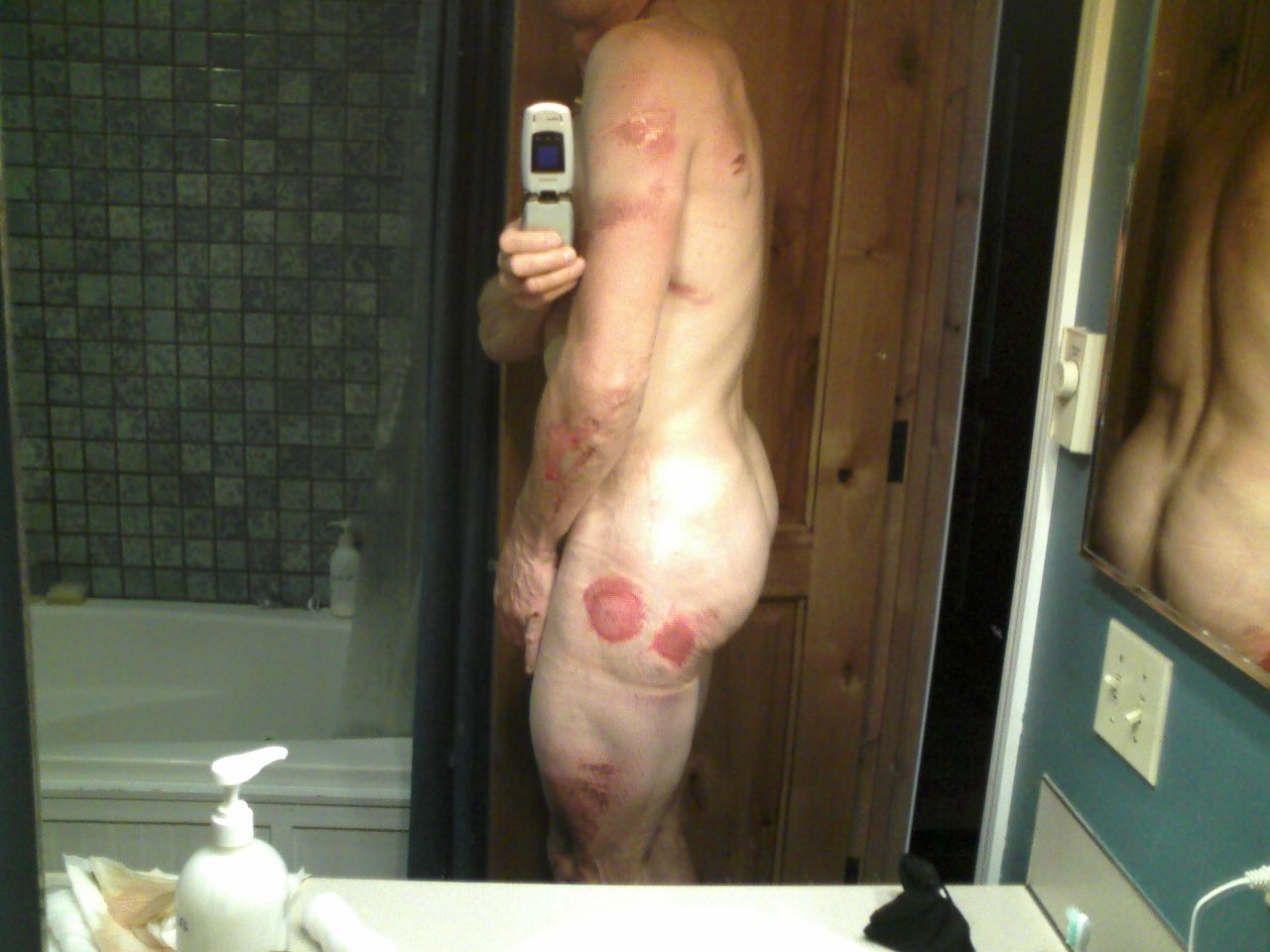Road Rash - Heal Thyself
 Monday, July 19, 2010 at 11:35PM
Monday, July 19, 2010 at 11:35PM "It is not the critic who counts. Not the man who points out how the strong
man stumbled or where the doer of deeds could have done better. The credit
belongs to the man who is actually in the arena, whose face is marred by
dust and sweat and blood; who strives valiantly; who errs and comes short
again and again; who knows the great enthusiasms, the great devotions;
who spends himself in a worthy cause. Who, at the best, knows in the end
the triumph of high achievement, and who at the worst, at least fails while
daring greatly, so that his place shall never be with those timid souls who
know neither victory nor defeat."
- Theodore Roosevelt
When I decided to start racing my bike a few seasons ago, one thing lurking in the back of my mind was crashing. Hitting the deck is nearly inevitable if you race long enough and hard enough. Certainly the more you push, the closer to the edge you get, and sometimes you end up on your hip sliding across the pavement, grinding your flesh away in the process. I've had a racing license since 1987 and have lost my share of skin. Thankfully, that's been the worst of it - no broken bones to date. Still, dealing with the aftermath of these injuries is typically worse than getting them. The searing pain of the first shower, the oozing wounds, the sticky sheets, difficulty sleeping and the annoying, frequent dressing changes all make for a tedious couple of post-crash weeks.
With my recent experience of last lap, back-to-back, high speed crashes and the subsequent loss of skin, I thought this might be the perfect opportunity to share with you my favorite wound care strategies. Now, these are born by both my extensive experience with my own wounds and those of several friends with similar histories. Being a medical professional (Physician Assistant) I'm also a bit of a geek when it comes to this sort of thing. I know, big surprise, right? The techniques and recommendations for wound management found below are based on sound medical research into wound care. There is no lack of studies to read on the topic and the salient points are summarized. However, if you want to geek out yourself, just Google "wound care" and you will find all you need.
Rider Down
So, there you are, ripping along in your favorite criterium, knocking elbows, fighting for position with a lap or two to go. The corners are coming fast and you're coming in hot. The line is a little different now that the pace is higher. You can round the course dozens of times and handle each turn smoothly without incident. Then, the last couple of laps come and things can go sideways suddenly. It's completely unpredictable. I don't make crashing a habit but this year I've been down 4 times. Twice was someone else's fault with me having little choice than to run them over after they crashed. The other two were all me with my front wheel losing solid contact in the apex of a turn on the last lap. Not sure why. Freaks me out a little since I don't know if it's my tires, speed, technique, or just bad luck. Hard to know.
In any case, you are now on the deck, sliding along at around 50 kp/h. Some people have more wits about them than others in this instant. For me, I try to get as much surface area of my body on the ground as possible to dissipate the energy. Scrapes tend to be more superficial with this technique. On Sunday, as I started sliding on the previous night's wound, I consciously rolled further onto my buttock to grind down a different spot. Nice! With all the adrenaline, it doesn't really hurt that much. Bystanders always rush up to help. This last time, I was too busy cursing in frustration at the top of my lungs to pay them much attention. I simply grabbed my bike out of their hands and rode to the finish, head hanging in shame.
 Sorry about the butt shot but you get the idea. Shoulder, back, forearm, hip, thigh, knee, ankle. Something for everyone!
Sorry about the butt shot but you get the idea. Shoulder, back, forearm, hip, thigh, knee, ankle. Something for everyone!
No time to waste
A quick assessment reveals superficial bleeding of the ankle, knee, hip, shoulder, and elbow/forearm. The kit is shredded…again. Now what? Well, for me, it's getting to some first aid so that the wounds can be washed thoroughly as soon as possible. There are two reasons not to delay here. One, with all the adrenaline coursing through your veins, pain response is blunted and you can get to the task of vigorously scrubbing the gravel out of the wounds without hurting as much. Two, the sooner the wounds are cleaned, the lower the chance of infection. This is well documented in the medical literature. Just get it done now!.
The next step is to actually get the wounds clean. Now, this is not for the meek. If you are man enough to put yourself in harm's way in a bike race then you better be tough enough to thoroughly deal with the aftermath when things go wrong. Aggressively scrubbing out a raw stretch of road rash is not for pussies. If you can't handle it or if it is someplace you cannot reach then grab a friend and head for a shower. Here are some of the more important details.
First, copious irrigation is THE most important aspect of wound cleansing. We're talking liters of fluid here (the solution to pollution is dilution). The shower is perfect. Not only do you have an endless stream of clean water flowing over the wound, you can also apply some water pressure. This detail has also been shown to be key to infection prevention. Somewhere around 8 psi does the trick. Now, with scrapes, this is less important but in those big divots get some pressure behind the irrigation. A 60 cc syringe and an 18 gauge needle with a few liters of clean water will get it done if you are not near a shower immediately.
Irrigation options
It's important to note that you do not need a bunch of fancy solutions to clean a wound. If the water is clean enough to drink then it will work. Sterile water or saline is not necessary. In fact, the emergency medicine literature points out that studies done comparing sterile solutions to tap water with regards to infection rates indicate that tap water has slightly lower, although not statistically significant, rates of infection. There is also a temptation to use providine/iodine solution, hydrogen peroxide or chlorhexidine gluconate (Hibiclens) cleanser to do the deed. Truth is, these solutions are toxic to viable tissue and are unnecessary if you have enough volume of clean water. If you are in a remote area with dubious water quality, then adding some iodine to the irrigant can make it acceptable. You only need to add enough water purifier to make it potable. Remember, this stuff is toxic to tissue. If it makes you feel better using this stuff initially, go ahead. The tissue is already pummeled. But avoid the temptation to use them for supplemental cleansing on multiple days as they will definitely impair the healing response.
With some wounds common in cycling crashes it is necessary to do some "mechanical" removal of dirt and debris. I find that a soft nail brush or surgical scrub brush will do the job nicely. There is no easy way to do this but to simply grit your teeth and go to town. Yes, there may be some additional soft tissue trauma while scrubbing but it is imperative that all that crap is removed. Follow the scrubbing with additional irrigation and your wounds will be ready to start healing.
Dressings
Road rash is really a type of burn with removal of significant amounts of superficial skin layers. These wounds ooze a lot in the first two or three days. Once epithelialization is under way around day three, the drainage slows significantly and dressing choices shift along with it. Initially, though, you need bulky, absorbent sponges. Some sort of non-adherent layer next to the skin is nice and makes dressing changes less painful. Although some doctors will tell you that you don't need ointments under the dressings, most research indicates that Bacitracin or Triple Antibiotic ointment actually reduces bacterial counts in wounds in the first two days and speeds healing of the wound by three or four days. So, I recommend putting a thin layer on followed my a Telfa (no-stick) pad and then something thick and absorbent. Adaptic is another non-adherent dressing that works well under sponges.
Holding all this in place can be a hassle and depends upon what body part is involved. Surgilast tube net bandages are elastic sleeves that work great for holding dressings onto limbs. They eliminate irritating adhesive tape and allow greater freedom of movement. Micro foam tape is a good choice for larger surfaces and also possesses good flexibility. If you need to use tape, shaving thick hair from the area will aid in maintenance for the next week or two.
Once the wound stops draining so much, you can switch to less bulky options with an increase in convenience. Daily dressing changes are typically required. Things get stinky and messy otherwise. Simply take off all the dressings and jump in the shower. I would not go crazy with soaps on the wound bed as these can kill early granulation tissue. Simply rinse the area with clean water and leave it at that. Dry it with sterile gauze to avoid recontamination. Once again, I go with a thin layer of Bacitracin and then a simple Telfa pad cut to size. On top of this I add the god-send of wound dressings, Tegaderm made by 3M. This clear, flexible, slightly permeable membrane dressing is sweet and keeps your clothes dry and you can even shower over them. If the wound is still weeping a bit, the fluid typically will collect under the film like a little water balloon. If you are not too hairy, they rarely leak. With this kind of collection, it's imperative to change the dressing daily. Once the wound is fairly dry, I will leave them on for a couple of days. The only downside of Tegaderm is that they are expensive. Order them on-line in bulk and save a ton. Split boxes with your friends.
To Scab or Not to Scab
I realize that some of you are asking why bother with all this hassle in the first place. Hell, mom said to "let the wound breathe and scab over," right? Yeah, well, not all her advice was so good. Truth is, the formation of granulation tissue and re-epithelialization take place more favorably in a moist environment. That is what a scab provides, really. But scabs are also stiff, thick, non-pliable structures that prolong wound healing a few days. I think on small boo-boos they are fine. Why screw with the daily expense and hassle of what I describe above? But depending upon where the wound(s) is/are, covering road rash maybe the only way to spare your clothes, your sheets, and ensure a decent night's sleep. Plus, healing will be accelerated several days if the wound is kept covered until it's healed - about 9-10 days. In addition, if you are a compulsive scab picker like me (eeeewww!) it seems like these things go on for weeks.
De-scabbing
Once in a while I get lazy and let a wound scab over only to find myself digging at it each night and regretting it. It's not the end of the world and you can get the wound down to basement level easily in about 12 hours. Here's the technique: Apply a generous layer of ointment to the wound and cover with a Telfa and Tegaderm. Over the course of the day, the moist environment will soften and liquify the gnarliest of scabs. That evening, remove the dressing and shower. As you can see in the photos, the scab is completely gone and I'm down to a nice, fresh healing bed. Now, simply cover as usual and wait for the magic.
Oh, you want step by step pictures? Check it...
Apply antibiotic ointment to scab.
Cut Telfa pad to size.
Apply Telfa to sticky side of Tegaderm.
Put on wound and let it cook.
12 hours later and looking gooey!
Look, Ma. No more scab!
Now, this was just a little one on my back. I did this same process to my whole forearm and it was nice and pink 7 days later.
When to stop
Okay, I'll admit it. All this wound care bullshit is tedious and expensive. But once you see the fruits of your labors it's all worth it. Behold, lovely, pink new flesh, no scabs. Amazing, really. Stop the maintenance too early and the wound will scab. Go too long and, well, you only wasted some time and dressings. The test is usually to get out of the shower and let the wounds air dry for 5 or 10 minutes. If the wound is dry then you are done. If it still has a sheen or is sticky then reapply then Tegaderm for another day. Anticipate between 6 and 10 days for most road rash.
After care
One thing to remember is that this new tissue is very sensitive to environmental insult. Crash again and you will be back to square one. Also, you need to protect this skin from UV radiation so liberal use of sun screen is recommended. Although I'm sure some elitist road cyclists will find the idea of wearing protective gear a serious breach of style protocol, there are some riders showing up at races clad in some prophylactic equipment. I think they are typically master racers. No surprise there, really. We are too old for this road rash shit! I did some searching and found some "slide tackle" shorts for soccer players that have padded hips and are meant to wear as a base layer. These fit nicely under lycra. The other thing I'm still looking for is something low profile for my forearms and elbows. Let me know if you have any ideas. No criteriums on the horizon for the rest of this season but I will be protected if I line up next year. I'll be the freaking' shave-legged Road Warrior! Probably should get a funny mask. - Brian
 Brian |
Brian |  12 Comments |
12 Comments |  General
General 





Reader Comments (12)
Ouch. Stop crashing!
Tegaderm is great stuff.
Great info. Bad luck caught up with me. I crashed on my mountain bike and ended up with a few stitches in my elbow due to a couple of deepish cuts (in addition to road rashish wounds on arm, hip and leg). I actually wasn't going to get stitches, but couldn't remember the last time I had a Tetanus shot, so I went to the local instacare place (after very thoroughly cleaning everything myself) and the doctor recommended a few stitches. So can I use Tegaderm over my stitches? I will actually be up in your neck of the woods and will be ion the river this weekend and a good waterproof covering would help.
Must have been a good one.
With sutures in place, you do have a conduit for things to travel down into the wound, theoretically. Many surgeons would allow you do take a shower and get the wound wet with soapy water but would discourage any soaking in funky water until the sutures are out. If you can get a tegaderm to stick, it might be an acceptable alternative if you absolutely have to get in the water. I would remove it and clean the area with clean water after you are done. Also, after a few days, the suture line is typically closed and you can go dressing-free if you like and simply put a light shmear of Bacitracin over the wound to facilitate bacteriostasis and wound healing.
Brian, you don't know me, but I read your blog from time to time.
Very neat quote by Teddy. I'll have to take courage from that quote next time I'm getting kicked in the butt during a race. Great stuff!
I had no idea that Tegaderm was so effective at removing scabs. I'll have to remember that recipe for future road rashes. Thanks for sharing.
Alright, it's been a while since I posted a response, even though I do enjoy reading your blog, Brian. Fortunately, you have "dangled" one out there that is just too ripe for picking... (see revealing photo above). You could have at least donned a nice euro butt thong for effect. (rather than the "cupping", or the "CB", or the "complimentary reach around" on yourself.) And are you sure that those lesions on your upper thigh/butt area are actually "road rash"? They look like classic lyme's disease. Or maybe something herpetiform. You should have that looked at. One final thought... thank you for the info on descabbing, but you left out the most important part. How do you prepare them, or do you just eat them raw?
Intriguing response, Mr. uh...Flagstaff, shall we call you? Thanks for reading.
Obviously I was flying solo for that photo shoot. I'll keep your couture suggestions in mind on future efforts.
Saute'd, a little garlic, salt and pepper to taste.
Hey Brian, that's really helpful stuff, cheers. In fact you may be able to answer a question for me....
A long time ago, I lost all the skin off of my back from some mega road-rash when a car hit me when out for a run (I was on the sidewalk at the time). Most of the skin damage healed relatively quickly but I had a few large areas of inch deep gouges which took a strange turn. After a couple of weeks of dressing, the gouges scabbed over and I accepted I'd be left with these deep marks in my back for the rest of my days. Then, the scabs seemed to liquify all by themselves, which was just weird after weeks of careful wound management and eventually filled themselves in and healed over. It was a pretty noticeable 2-stage process.
It was almost as if the body stopped one day and said "oops, haven't finished healing that bit" and just decided to undo the process and start off afresh. Weird, and never experienced anything like it since thankfully. Is this normal for deep large-area wounds? It's always intrigued me.
Thanks for a great site BTW.
Nick,
Sounds gnarly, being hit by a car and on the side walk and all. Can't imagine!
What you describe sounds like your wound developed what we call eschar. This is usually black, tough, thick necrotic tissue around deep wounds or burns. It's different from a scab which is just dry exudate. Eschar has some tissue component to it. Your experience is typical. It takes a long time for a wound to heal under the eschar. When we see it in the clinic, we will usually debride or cut it out down to healthy, bleeding tissue. It really gets in the way otherwise. Sounds like your body finally got the better of it and did the deal by itself. Makes for a nice scar, I bet.
Wow Brian, 23 years later and I get an answer! Many thanks for that. I probably should have paid more attention in my WFR class...
Although I don't recommend the experience, the scars did get me loads of attention from girls at the beach asking "is that a shark-bite?"
Great post; something a lot of us have dealt with and could probably handle better. I'll be keeping this in mind the next time I have to deal with the aftermath of taking a hard slide.
As far as equipment to protect your arms and elbows, maybe sliding pads or sleeves like baseball players use? (example: http://www.mcdavidusa.com/store/item.asp?ITEM_ID=152&DEPARTMENT_ID=56 ) It may not meet your low-profile requirement, but it's a place to start.
Wow, great post. Thanks so much for sharing. I have a wicked road rash down to the white meat on my elbow and forearm...not so cute for a chic.
Day 1: I put a DuoDerm pad on it but so much fluid/eschar collected under it, it started oozing out. So I replaced the duoderm pad with a generous slathering of Silvadene, telfa pads and some co-band to hold it all in there.
Question: Would you recommend putting a DuoDerm pad back on after day 4 or so?
CArgenti,
Thanks for reading an old one. Good to hear that stuff is still useful. It was fun rereading it. Funny, I just hit a speed bump on a bike path riding by myself. Blew both hands off the bars and down I went. Yep, using the above techniques on my forearm and hip. God, I HATE road rash!
Anyway, Duo Derm is great stuff. I didn't mention it because it's harder to work with but it's very effective. The wound has to be pretty dry or else it just gets pushed off like you found. However, once the wound "accepts" it, you can leave Duo Derm on for many days. As the wound heals, the free edge can be trimmed each day back to the adherent part. By 10 days you're usually done.
Hey, chics with scars are sexy!